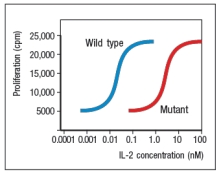Multiple Choice
A T cell line growing in culture is subjected to a chemical mutagen, and individual mutant lines are derived from this population. The individual mutant cell lines are each screened for their ability to proliferate in response to stimulation with antibodies to the T-cell receptor plus CD28 (anti-CD3 + anti-CD28) . In addition, the cells are treated with varying doses of added IL-2, and three days later, T cell proliferation is measured by 3H-thymidine incorporation (cpm) . The data for one mutant line and the wild-type control are shown in Figure Q16) . 
Figure Q16) The gene that is defective in this mutant T cell line most likely encodes:
A) The CD3 epsilon subunit of the T-cell receptor complex
B) The co-stimulatory molecule CD28
C) CD25, also known as the IL-2 receptor chain
D) The IL-2 receptor chain
E) The cytokine IL-2
Correct Answer:

Verified
Correct Answer:
Verified
Q26: To generate a vaccine to pertussis toxin,
Q27: The entry of naive T cells from
Q28: Cytotoxic T cells are rapid killers of
Q29: Chimeric mice are generated where approximately 50%
Q30: Cytotoxic granules released from cytotoxic T cells
Q32: Strep throat is commonly caused by group
Q33: Unlike innate immune responses, adaptive immune responses
Q34: Purified naive T cells isolated from a
Q35: Naive T cells are isolated and left
Q36: Effector caspases are activated downstream of both